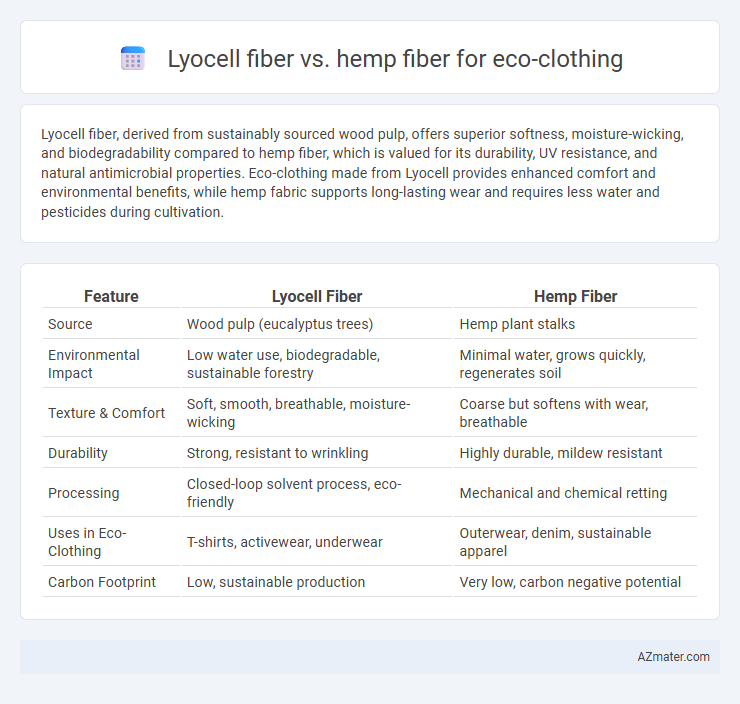Lyocell fiber, derived from sustainably sourced wood pulp, offers superior softness, moisture-wicking, and biodegradability compared to hemp fiber, which is valued for its durability, UV resistance, and natural antimicrobial properties. Eco-clothing made from Lyocell provides enhanced comfort and environmental benefits, while hemp fabric supports long-lasting wear and requires less water and pesticides during cultivation.
Table of Comparison
| Feature | Lyocell Fiber | Hemp Fiber |
|---|---|---|
| Source | Wood pulp (eucalyptus trees) | Hemp plant stalks |
| Environmental Impact | Low water use, biodegradable, sustainable forestry | Minimal water, grows quickly, regenerates soil |
| Texture & Comfort | Soft, smooth, breathable, moisture-wicking | Coarse but softens with wear, breathable |
| Durability | Strong, resistant to wrinkling | Highly durable, mildew resistant |
| Processing | Closed-loop solvent process, eco-friendly | Mechanical and chemical retting |
| Uses in Eco-Clothing | T-shirts, activewear, underwear | Outerwear, denim, sustainable apparel |
| Carbon Footprint | Low, sustainable production | Very low, carbon negative potential |
Introduction to Eco-Friendly Textiles
Lyocell fiber, derived from sustainably sourced wood pulp, offers exceptional softness, moisture-wicking properties, and biodegradability, making it a popular choice for eco-friendly textiles. Hemp fiber, known for its durability, UV resistance, and minimal water and pesticide requirements during cultivation, provides a strong and sustainable alternative in eco-clothing production. Both fibers contribute significantly to reducing environmental impact through renewable sourcing and biodegradability, aligning with the principles of sustainable fashion.
What is Lyocell Fiber?
Lyocell fiber is a sustainable cellulose fiber made from wood pulp, commonly sourced from eucalyptus, beech, or spruce trees, processed through an eco-friendly closed-loop system that recycles water and solvents. Known for its softness, breathability, and moisture-wicking properties, Lyocell is widely used in eco-clothing as a renewable alternative to conventional fabrics. Compared to hemp fiber, which is coarser and more durable, Lyocell offers a smoother texture and a more versatile fabric suitable for lightweight garments and sensitive skin.
What is Hemp Fiber?
Hemp fiber, derived from the stalks of the Cannabis sativa plant, is a highly sustainable and biodegradable material renowned for its strength and durability in eco-clothing. Compared to Lyocell, which is produced from wood pulp through a closed-loop process, hemp requires minimal water, pesticides, or synthetic fertilizers, making it an environmentally friendly choice with a lower carbon footprint. Hemp fibers also possess natural antimicrobial properties and excellent breathability, contributing to comfortable, long-lasting, and eco-conscious textile options.
Environmental Impact: Lyocell vs. Hemp
Lyocell fiber, produced through a closed-loop process that recycles water and solvents, significantly reduces environmental pollution compared to conventional fibers but still relies on wood pulp sourced from trees, which can impact deforestation if not managed sustainably. Hemp fiber, on the other hand, requires minimal pesticides and herbicides, grows quickly with low water consumption, and improves soil health through crop rotation, making it one of the most eco-friendly options in textile production. While Lyocell offers softness and biodegradability, hemp outperforms in reducing agricultural chemical use and carbon footprint, positioning it as a superior choice for sustainable eco-clothing.
Production Processes Compared
Lyocell fiber production involves the closed-loop process using non-toxic solvents like N-Methylmorpholine N-oxide, allowing 99% of chemicals and water to be recycled, significantly reducing environmental impact. Hemp fiber production requires retting, which can be water-consuming and prone to pollution but uses fewer pesticides and herbicides than conventional cotton, making it more sustainable. Comparing both, Lyocell offers a more controlled, low-emission production system, while hemp cultivation benefits from natural biodegradability and minimal agricultural inputs.
Durability and Performance in Clothing
Lyocell fiber offers superior softness, moisture-wicking, and breathability, making it ideal for comfortable, performance-driven eco-clothing. Hemp fiber stands out for its exceptional durability, resistance to abrasion, and natural antimicrobial properties, providing long-lasting strength in garments. Combining Lyocell's smooth texture with hemp's toughness can optimize sustainable fabric blends for enhanced wearability and environmental benefits.
Comfort and Wearability Factors
Lyocell fiber offers exceptional softness, breathability, and moisture-wicking properties, making it highly comfortable for eco-clothing applications. Hemp fiber is durable, hypoallergenic, and becomes softer with use, but may feel coarser initially compared to Lyocell. Both fibers provide sustainable options, with Lyocell excelling in lightweight wearability and Hemp delivering superior strength and longevity.
Biodegradability and End-of-Life Considerations
Lyocell fiber, derived from sustainably sourced wood pulp, is fully biodegradable under industrial composting conditions, breaking down within weeks without releasing harmful substances. Hemp fiber, a natural bast fiber, exhibits excellent biodegradability in soil environments, decomposing rapidly and enriching the soil with organic matter. Both fibers offer eco-friendly end-of-life options, but hemp's minimal processing and strong natural durability contribute to a lower environmental footprint during disposal.
Market Availability and Cost
Lyocell fiber, derived from sustainably sourced wood pulp, is widely available on the global market due to its efficient production process and growing demand in eco-clothing. Hemp fiber, known for its durability and natural resistance to pests, tends to have a more limited market presence and higher production costs because of slower cultivation cycles and processing challenges. Cost-wise, Lyocell is generally more affordable and accessible for manufacturers, making it a popular choice for sustainable fashion brands seeking scalable eco-friendly materials.
Choosing Between Lyocell and Hemp for Sustainable Fashion
Lyocell fiber, derived from sustainably sourced wood pulp, offers a soft, breathable texture with excellent moisture-wicking properties, making it ideal for comfortable eco-clothing. Hemp fiber, known for its durability, natural antimicrobial qualities, and low water usage during cultivation, provides a robust and long-lasting option for sustainable fashion. Choosing between lyocell and hemp depends on prioritizing softness and drape versus strength and environmental impact in eco-friendly apparel design.

Infographic: Lyocell fiber vs Hemp fiber for Eco-clothing
 azmater.com
azmater.com